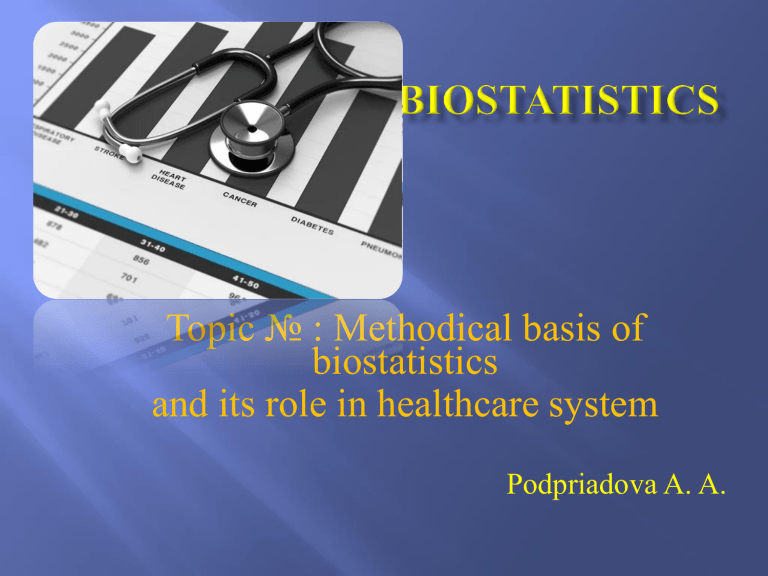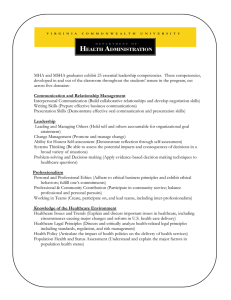
Topic № : Methodical basis of biostatistics and its role in healthcare system Podpriadova A. A. To learn the content of the definition “biostatistics”, “statistical aggregate”, “observation unit”, “characteristics taken into account”, “representativeness” and other terms. . independent public science, studies the quantitative aspect of mass, public events in connection with their qualitative part in specific historical conditions. Biostatistics is one part of the general statistics. Biostatistics studies general and particular patterns that are inherent in living nature, using statistical methods. as science statistics became to develop in medium 17 century, here with it was formed in two main trends: -descriptive -mathematical (political arithmetic) were a german scientist Konring (1606-1681) and G.Ahenval (1719-1772). Ahenval for the first time entered the term "Status" that means "determined position of the things or condition". The undoubted relationship and with Italian word "stato" (the state). of the statistics appeared in England. The most important representative of this direction were John Graunt (1620-1674 ) and William (Uiliyam) Petti (1711-1785). William (Uiliyam) Petti was offered term "Statistics" from latin word -"Status". In connection with than V. Petti have named the inventor of the statistics. - Is a part of general statistics, which studies issues related to medicine, hygiene and health care. 1. Public health statistics; 2. Health care system statistics; 3.Statistics socio-hygienic, clinical, experimental and other studies, assessment of the reliability of study results. studies the quantitative aspect of public health as a whole and various groups (demographic indexes, morbidity, disability, physical development, prenozological condition), dependence between public health, complex biological, medical and social factors and environmental factors. studies medical staff, health care facilities, assesses the activity of health authorities and institutions, as well as measures to protect public health. It supports organization and conduction of various statistical studies methodologically. As well as it allows to assess reliability of obtained results with justification of recommendations for healthcare system. 1) study the state of population health (demographic processes, population morbidity, physical development and disability); 2) establishment and identification of cause-effect relationships morbidity, mortality, disability of population, depending on various factors and environmental conditions; 3) study and analysis data of personnel in healthcare system and a network of medical healthcare institutions with the aim of planning and determining population needs in various kinds of medical care; 4) evaluation of the quality and efficiency of healthcare institutions, as well as medical and recreational activities for morbidity and mortality prevention; 5) evaluation of the reliability of statistical studies’ results which were received after medical – social, clinical and experimental studies. includes different statistical totalities (statistical aggregates), which are formed depending on the purpose of the study. is a large group, consisting of a large number of relatively homogeneous units of observation, which were taken together within certain limits of time and space for a particular purpose. Statistical population consists of observation units. Observation unit is every primary element of statistical aggregate. purposes of the statistic research- to study the hospitalized morbidity in Ukraine in 2013 year. Statistical totality- all cases of hospitalization in Ukraine in 2013y. Unit of observation- each case of hospitalization in Ukraine in 2013y. border of space- Ukraine border of time- 2013y. Signs describing observation units(the sex, age, profession and etc.) 1. Attributive -a signs of the descriptive nature (the sex, profession, result of the treatment and etc.). 2. Quantitative- expressed in numbers(the growing, weight, age). 1.Alternative signs (a signs, having 2 means (yes or no)); 2. Discrete signs ( quantitative signs, which can be represented only by certain values, without intermediate values and expressed with integers – number of floors 1,2,3; number of children in family 1,2,3); 3. Continuous (increate) - a quantitative signs continuously varying and can be represented by any value ( child’s height –1m., can be 1.5m., and etc.). These importance can be both integer, and fractional. 1. Instant -characterize object at a particular time (the physical examination on 1 March 2005). 2. Interval -characterize objects within a certain period of time (the month, year and etc), for example, amount given birth or deceased from 1 January to December 31). general selective consists of all observation units that may be allocated to it in accordance with intended purpose of the study. is a part of a general statistical aggregate (statistical totality), selected by a special sampling method. It is intended for characteristic of general statistical aggregate. 1. It must have main characteristics of general statistical aggregate. 2. It has to be sufficient in volume, in order to express general properties of statistical aggregate more fully. 1. The Casual selection; 2. The Mechanical selection; 3. Typological selection; 4. The Serial selection; 5. The Directional selection 1. Distribution of a certain signs is expressed by relative values. 2. Medium level of sign (Mode, Median, arithmetic mean). 3. Variety of sign (Limit, Amplitude, Sigma). 4. Representativeness. 5. Ratio between signs. 1. Documentary (coping data). 2. Anamnestic method: - questionnaire; - corresponding; - registration; - expeditionary. 3. Direct observation






